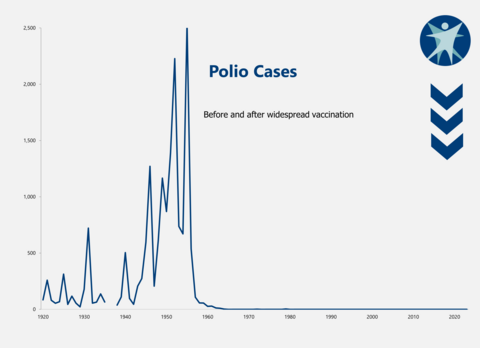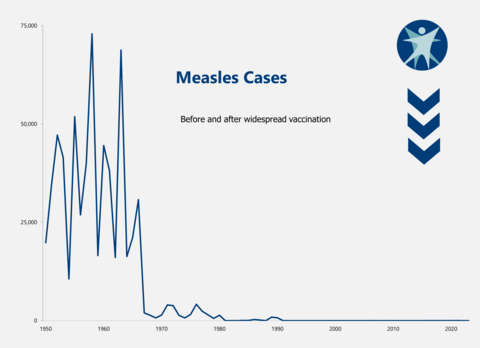Immunizations: Get the Facts About Vaccines
Viruses lurk all around us, hiding in classrooms, lunchrooms, playgrounds, and parks. While these invisible threats are nearly impossible to avoid, safe and effective vaccines can protect you from them. After rigorous testing and monitoring, vaccines have been proven to prevent serious illness, save lives, and protect communities—acting as the first line of defense for your child’s health.
View the other videos in this series featuring Dr. Jasmine Zapata on the Wisconsin Department of Health Services (DHS) YouTube page.
Vaccine approval process
Before each vaccine gets to your doctor's office, clinic, or pharmacy, they go through a rigorous approval process to make sure they are safe for people and effective against diseases. After approval, a vaccine's safety and effectiveness is closely monitored by many medical experts and organizations.
The journey to creating a safe and effective vaccine is:
- Vaccine research: Medical researchers begin their search for a vaccine by studying the germ and the disease. Then researchers use the latest, high quality medical research to determine the best ingredients to make a safe and effective vaccine.
- Test for safety and effectiveness: Each vaccine is carefully tested to prove its safety and effectiveness. Testing starts in a research laboratory. The results of these tests must be reported to the U.S. Food and Drug Administration (FDA) and researchers can then request to test the vaccine on people who volunteer for a clinical trial. This process can take years.
- Review and approval: Researchers submit the results of all their testing, including clinical trials, to the FDA, where medical experts look carefully at every piece of data. If they determine the vaccine is safe and effective, the FDA experts give approval for use. The FDA then sends its approval of the vaccine to the CDC (Centers for Disease Control and Prevention) to re-review the data and recommend a safe immunization schedule.
- Monitoring: Vaccines are continually monitored by the FDA and CDC. If new medical research changes our understanding of how to prevent a disease or improve treatments, or if any medical concern is discovered, these experts can update their recommendations for the vaccine.
For a more detailed understanding of how vaccines are developed, read The Journey of Your Child’s Vaccine.
Demonstrated results
See the impact
For decades, vaccines have been a powerful tool in preventing serious illness and death from diseases. Medical experts constantly study them to ensure that they continue to be safe. Measles, mumps, and polio are just a few of the vaccine-preventable diseases that have been significantly controlled through widespread vaccine use.
After the first polio vaccine was introduced in 1955, the number of polio cases decreased greatly in Wisconsin and in the United States.
After use of the measles vaccine became routine and widespread during the 1960s, the number of measles cases decreased substantially.
Frequently asked questions
Vaccines help the body learn how to defend itself, without the dangers of getting sick.
Vaccines have a small piece of a germ, or a weak form of a germ, in them. This is called an antigen. When your body sees this antigen, it uses your immune system to create defenses.
If you encounter the germ in the future, your immune system remembers how to defend itself, protecting you from serious illness or preventing illness.
Just like any medicine or supplement, a vaccine can have side effects. A side effect is a symptom you experience after you get a vaccine. Some people experience a side effect after a vaccine, while others may not.
The most common side effects are temporary soreness, redness, or swelling at the site of the vaccine or a low fever. These side effects usually go away in a few days.
Learn more from the CDC on Possible Side Effects of Vaccines.
Vaccine ingredients help make the vaccines work better. For example, thimerosal, a preservative, is added to some vaccines to protect the vaccine from bacteria and fungus. Thimerosal leaves the body quickly, so it doesn’t build up or cause harm.
The CDC offers details about thimerosal and vaccines. Learn more from the CDC on what’s in vaccines.
The CDC and the FDA monitor approved vaccines in several ways, including:
Vaccine Adverse Event Reporting System (VAERS). VAERS accepts reports on adverse events that happen after a vaccine. Anyone, including health care providers and the public, can report to VAERS. VAERS is one important piece in monitoring vaccines, and VEARS alone cannot be used to learn if a vaccine is the cause of an adverse event. Medical researchers use scientific studies to determine if adverse events reported in VAERS are caused by a vaccine.
Vaccine Safety Datalink (VSD). VSD monitors possible side effects of vaccines, including using information from VAERS. When there is a safety question or concern, medical scientists perform safety studies to learn more.
Clinical Immunization Safety Assessment (CISA). CISA is a network of vaccine safety experts from the CDC and other partners. CISA does safety studies and research, and will work with health care providers about complex vaccine safety questions.
- Most private health insurance plans cover vaccines at no extra cost to you. Call your insurance provider to ask what’s covered under your plan.
- Medicaid pays for many vaccines and Medicaid-eligible people may be eligible for transportation assistance.
- The Vaccines for Children Program and the Vaccines for Adults Program provide no-cost vaccines for eligible people.
Vaccine schedules are based on how your child’s immune system responds to vaccines at different ages and how likely your child is to be exposed to a particular disease.
Talk to a trusted health care provider, visit the DHS childhood vaccine page, or use the CDC Childhood Vaccine Assessment Tool to see which vaccines your child needs.
For additional questions about vaccinations, talk to a trusted health care provider.
Where to get vaccinated
Today, vaccines are easier to get than ever, available at many pharmacies, doctor’s offices, local health departments, and Tribal health departments.
Call your doctor’s office, pharmacy, or health insurance company to learn where you can get vaccines and how much it will cost. You can also visit vaccines.gov or call 211 to find flu, RSV, and COVID-19 vaccine locations near you.
Eligible children under 19 years old can get vaccines at no cost through the Vaccines for Children Program. Learn more about the Vaccines for Children Program and find a provider near you.
Eligible adults can get some vaccines at no cost through the Vaccines for Adults Program. Learn more about the Vaccines for Adults Program and find a provider near you.
Contact us
- Local health departments
- Regional offices
- Tribal health departments
- Email the Wisconsin Immunization Program at DHSImmProgram@dhs.wisconsin.gov




